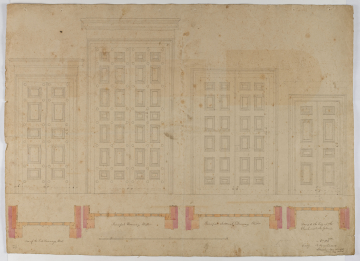
Browse
Reference number
Purpose
Aspect
The elevations show the designs for four sets of panelled, double doors intended for different locations within the church. On the left-hand side there is a 10-panel double door, with three sets of half-sized panels. The stiles, rails and mullions are interspersed with round studs, and the door is topped by a cornice. Beside this, are double doors which are the largest in dimensions and have 28 panels with three sets of paired half-sized panels, with studs and the door is topped by a cornice. Beside this, there are double doors with 24 panels with two sets of paired half-sized panels. To the right-hand side the double doors have 8 panels with two sets of half panels and these are the smallest double doors, and hatched lines above indicate a possible cornice
Scale
Inscribed
Signed and dated
- January 1826
Lincolns Inn Fields / January 1826.
Medium and dimensions
Hand
Soane Office Day Books record Mocatta and others making copies of drawings for Marylebone Church. 6 January 1826 has Mocatta ‘Drawing Parts at Large’ and the letter types conform to Mocatta’s hand such as the D, C, and looped h`
Watermark
Level
Sir John Soane's collection includes some 30,000 architectural, design and topographical drawings which is a very important resource for scholars worldwide. His was the first architect’s collection to attempt to preserve the best in design for the architectural profession in the future, and it did so by assembling as exemplars surviving drawings by great Renaissance masters and by the leading architects in Britain in the 17th and 18th centuries and his near contemporaries such as Sir William Chambers, Robert Adam and George Dance the Younger. These drawings sit side by side with 9,000 drawings in Soane’s own hand or those of the pupils in his office, covering his early work as a student, his time in Italy and the drawings produced in the course of his architectural practice from 1780 until the 1830s.
Browse (via the vertical menu to the left) and search results for Drawings include a mixture of Concise catalogue records – drawn from an outline list of the collection – and fuller records where drawings have been catalogued in more detail (an ongoing process).

